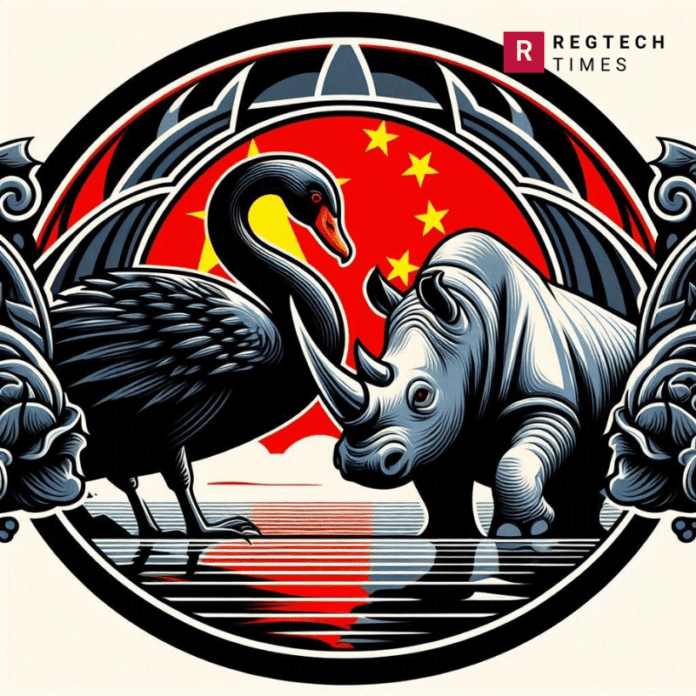China is getting ready for possible disasters, as President Xi Jinping mentioned. He used two unusual terms to describe these potential problems: “black swan” and “gray rhino.”
A “black swan” is an unexpected event that has major effects. Imagine something happening out of the blue, like a sudden natural disaster or a big economic crash. No one sees it coming, but it changes everything.
On the other hand, a “gray rhino” is a problem that we know about but often ignore until it’s too late. It’s like seeing a big, slow-moving rhino heading towards you and not doing anything about it. This could be a known issue, like rising debt or a simmering conflict, that people don’t address until it causes a crisis.
President Xi has warned that Gray Rhino and Black Swan types of events could happen more frequently. This means China needs to be prepared for surprises and known problems alike.
Current Global and Domestic Challenges
China faces a mix of global and local challenges that could lead to these “black swan” and “gray rhino” events. One major concern is regional conflicts. For instance, tensions are high in places like Taiwan and the South China Sea. These areas are becoming hotspots for potential conflicts that could escalate quickly.
Taiwan is an island that China considers part of its territory, but it operates like an independent country. The South China Sea is a vital waterway where several countries, including China, have competing claims. Any clash in these areas could have significant impacts.
In the Shadow of Tensions: Philippines-USA Talks in the South China Sea
Another issue is China’s economy. The country is dealing with problems like a slump in the real estate market and rising local government debt. The real estate market is important because many people invest their money in property. If property values drop, it can hurt the economy. Local governments, on the other hand, have borrowed a lot of money to fund development projects. High debt levels can lead to financial instability if not managed properly.
China Real Estate Crash Alert; Slowing Economy Have Cascading Global Repercussions
President Xi highlighted that the world is going through extreme changes, with increasing regional conflicts and external pressures. These pressures come from other countries, especially from the West, led by the United States. High tariffs, trade wars, and political tensions are some of the external challenges China faces.
China’s Strategy for Dealing with Risks
To tackle these risks, China has laid out a detailed plan. This plan includes 60 provisions and over 300 reform tasks aimed at boosting the country’s security and technological capabilities.
A significant part of this plan focuses on developing advanced technology. By advancing in technology, China aims to strengthen its economy and military. This includes enhancing military and supply chain security. The supply chain is crucial because it involves the production and distribution of goods. Securing it ensures that the country can maintain its economic stability even in times of crisis.
Taiwan-US Defense Talks Amidst Geopolitical Tensions and China Military Maneuvers
The plan also emphasizes the role of state-owned enterprises. These are companies controlled by the government. China wants these enterprises to play a key role in the economy, ensuring that private businesses and finances are also managed under state leadership. This approach aims to use national resources effectively to build economic power.
National defense is another critical area highlighted in the plan. Improving national defense means enhancing the country’s ability to protect itself from external threats. This includes boosting the defense technology industry, which involves creating and maintaining advanced military equipment and systems.
China Defiantly Unfazed by AI Chip Sanctions Imposed by US, Sets Up $47.5 Billion Fund
According to reports, these measures are intended to counter Western pressures. By strengthening economic, technological, and military capabilities, China aims to be ready to face any threats. This preparation is crucial, especially given the high tensions in regions like the Taiwan Strait and the South China Sea.
Squad Shield: US Prefers Philippines over India Amid Rising South China Sea Tensions
President Xi has previously used the terms “black swan” and “gray rhino” during times of economic difficulty. In January 2019, when China’s economic growth rate fell to 6.6%, the lowest in 28 years, he first mentioned these risks. He brought them up again in January 2021, when the new U.S. administration took office, signaling potential challenges ahead.
The document released during the third Plenary Session of the 20th CPC Central Committee outlines these strategies in detail. It underscores the importance of being prepared for both unforeseen and foreseeable risks.
Understanding the Bigger Picture
It’s important to understand why China is focusing so much on these potential risks. The world is interconnected, and what happens in one country can affect many others. For instance, if there is a conflict in the South China Sea, it can disrupt global trade routes. Similarly, economic instability in China can impact global markets, given its significant role in the world economy.
By preparing for “black swan” and “gray rhino” events, China aims to protect its national interests and ensure stability. This preparation involves not just military and technological advancements but also economic reforms and strategies to manage potential crises.
UAE’s Falcon Shield Exercise Unveils Unexpected Chinese Espionage Threats for US
In summary, China is gearing up for possible crises by addressing both Gray Rhino and Black Swan events and unexpected or known risks. This comprehensive approach includes enhancing technology, securing supply chains, and boosting national defense. By doing so, China hopes to navigate through these challenging times and maintain its position on the global stage.


